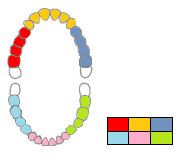 | ||
A periodontal examination is a clinical examination of the periodontium (gums). It is routinely carried out in dentistry and allied specialties. Many different techniques are used around the world.
A report by World Health Organization in 1978 led to the creation of the Community Periodontal Index of Treatment Needs (CPITN) and a periodontal probe termed WHO 621 ("Trintity"). It has a ball end of diameter 0.5 mm and a first colored band at 3.5 - 5.5 mm. Another colored band at 8.5 - 11.5 mm may be present. The CPITN was intended to provide a global standard for clinical practise and research, but several different periodontal screening tools were adapted from it. The Periodontal Screening and Recording (PSR) is increasingly used in the United States, Canada and Brazil. The Basic Periodontal Examination (BPE) is extensively used in the United Kingdom and New Zealand. The Primary Essential Periodontal Examination (PEPE) is used in Australia. All these methods use the WHO 621 probe.
Basic Periodontal Examination
This is the technique recommended by the British Society of Periodontology since its introduction in 1986. It is a screening tool which is used to quickly obtain a rough picture of the periodontal condition and treatment needs of an individual, but it does not provide an exact periodontal diagnosis.
For the purposes of a BPE, all the teeth in a person's mouth are divided into sextants (i.e. 6 parts), namely the upper right second molar to the upper right first premolar, the upper right canine to the upper left canine, the upper left first premolar to the upper left second molar, the lower right second molar to the lower right first premolar, lower right canine to the lower left canine, and the lower left first premolar to the lower left second molar. Wisdom teeth are not included because pericoronitis and tooth impaction may cause isolated periodontal defects which do not represent the general periodontal condition of the rest of the mouth. At least 2 teeth must be present in a sextant for it to be scored. If only 1 tooth is present in a sextant, the tooth is included in the adjoining sextant.
The probe is "walked around" measuring the depth of the gingival crevices/periodontal pockets (the gap between the tooth and the gums, "below the gumline") with a force of approximately 20 - 25 gm (about the force using when writing with a pencil). The worst finding in a sextant dictates the sextant's BPE score. The BPE is usually recorded in a table of six boxes (see diagram). The scoring is as follows:
